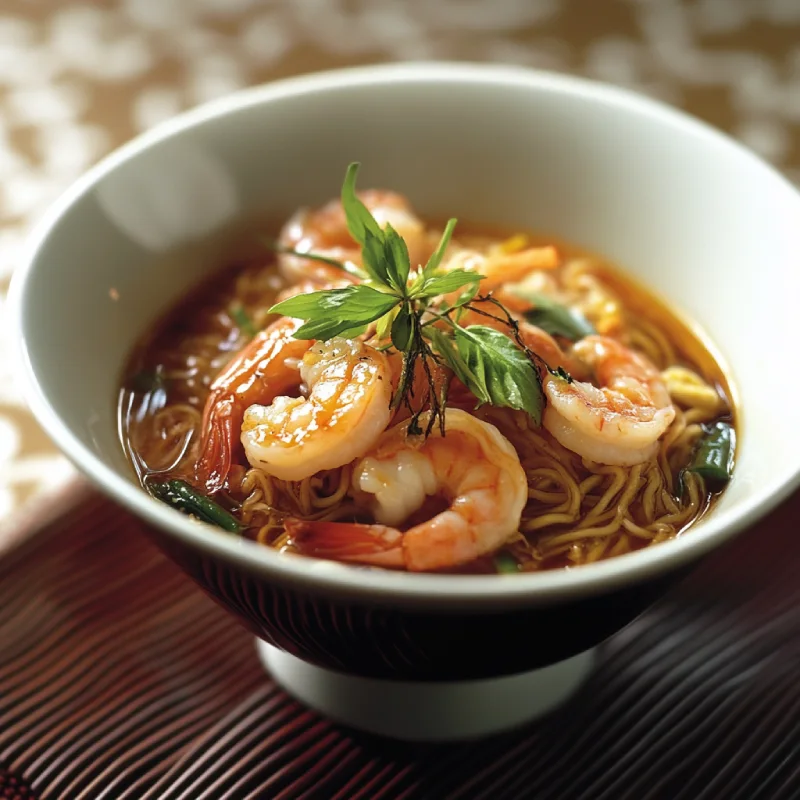1. Introduction to Shrimp Noodles Recipe
Shrimp noodles are a beloved dish, cherished by many for their quick cooking time and rich, satisfying flavors. Whether you’re a fan of spicy, savory, creamy, or light dishes, shrimp noodles can be customized to meet your taste. Their popularity comes from the perfect combination of juicy shrimp and tender noodles, which absorb the flavors of the sauces and seasonings beautifully.
These noodles are an ideal go-to for busy weeknights or when you need a flavorful meal without much fuss. From spicy chili garlic shrimp noodles to creamy garlic butter shrimp pasta, the possibilities are endless. The dish’s versatility makes it suitable for various cuisines—Asian, Italian, Thai, and more. Whether you want something simple or something to impress guests, shrimp noodles always deliver a flavorful experience.
2. Types of Shrimp Noodle Dishes
There are several varieties of shrimp noodle dishes that are popular across different cuisines. Some of the most well-loved include:
- Stir-Fried Shrimp Noodles: Classic Asian-style stir-fried noodles with vegetables, soy sauce, and plump shrimp.
- Garlic Butter Shrimp Pasta: An Italian-inspired dish combining garlic butter sauce with shrimp and noodles for a creamy, comforting flavor.
- Shrimp Lo Mein: A savory dish using lo mein noodles, mixed vegetables, and shrimp cooked in a light soy-based sauce.
- Spicy Chili Garlic Shrimp Noodles: Features gochugaru and garlic, perfect for those who love some heat.
The key difference between these dishes lies in their regional influences—Asian, Italian, or Thai—and the sauces used. For example, Asian-style dishes may use soy sauce and sesame oil, while Italian versions might include butter and herbs. Besides being delicious, shrimp is also a great source of protein, low in fat, and rich in omega-3 fatty acids, making shrimp noodles a nutritious choice.
3. Key Ingredients for Shrimp Noodles
To make a delicious shrimp noodles dish, here are the essential ingredients:
- Shrimp: The type of shrimp you use is important. Choose between jumbo or medium shrimp, depending on your preference. You can use shelled or unshelled shrimp, though shelled shrimp are easier to cook and eat.
- Noodles: There are many types of noodles that work well for shrimp dishes, such as:
- Egg noodles: Great for Asian-style stir-fry.
- Lo mein: Works perfectly for lo mein dishes.
- Udon: Thick and chewy, ideal for soaking up flavorful sauces.
- Rice noodles: A lighter option, often used in Thai dishes.
- Spaghetti: Suitable for garlic butter shrimp pasta.
- Sauces and Seasonings:
- Soy Sauce: You can use either light or dark soy sauce, depending on the flavor you desire.
- Gochugaru: A spicy Korean chili powder that adds heat to the dish.
- Other essentials include garlic, sesame oil, oyster sauce, and fish sauce, each bringing its own distinct flavor.
- Tips for Ingredient Substitutions:
- If you need a gluten-free option, substitute soy sauce with tamari. It provides a similar flavor without the gluten.
- You can also experiment with different noodle types. For instance, if you don’t have egg noodles, rice noodles or spaghetti can be used as alternatives, each offering a unique texture.
With these ingredients, you can make a variety of shrimp noodles dishes, each with its own distinct flair and flavor profile.
4. Cooking Methods for Shrimp Noodles
4.1 Shrimp Stir-Fried Noodles
For a classic shrimp stir-fried noodles dish, you will need the following ingredients: egg noodles, garlic, onion, carrots, and shrimp.
- Step-by-Step Instructions:
- Cook the egg noodles according to the package instructions. Drain and set aside.
- Heat a wok or large skillet over medium heat. Add some oil, then sauté garlic and onion until fragrant.
- Add the carrots and stir-fry until they start to soften.
- Toss in the shrimp and cook until they turn pink.
- Finally, add the cooked noodles and stir-fry for another 2-3 minutes until everything is well combined..
4.2 Garlic Butter Shrimp Noodles
Garlic butter shrimp noodles is an easy yet rich dish that highlights the classic flavors of garlic and butter, paired perfectly with shrimp.
- Ingredients:
- Shrimp, egg noodles, garlic, butter, lemon juice, parsley.
- Instructions:
- Cook the noodles as per package instructions. Drain and set aside.
- In a skillet, melt the butter over medium heat. Add garlic and cook until fragrant.
- Add the shrimp and cook for 2-3 minutes until they are opaque.
- Toss in the noodles, add lemon juice, and garnish with parsley. Stir well to coat everything in the garlic butter sauce.
4.3 Spicy Chili Garlic Shrimp Noodles
For those who enjoy a bit of heat, these spicy chili garlic shrimp noodles are a great option.
- Ingredients: Shrimp, udon noodles, gochugaru, garlic, sesame oil.
- Instructions:
- Cook the udon noodles and set aside.
- In a pan, heat sesame oil, then add garlic and gochugaru. Stir-fry for 30 seconds.
- Add the shrimp and cook until pink. Toss in the noodles and stir-fry until well combined.
5. Recipe Variations and Flavor Profiles
5.1 Creamy Garlic Shrimp Pasta
Creamy garlic shrimp pasta is a comforting dish that combines Parmesan cheese, garlic, and shrimp to create a rich, creamy texture.
- Ingredients: Shrimp, pasta, heavy cream, Parmesan cheese, garlic, butter, parsley.
- Instructions:
- Cook the pasta and set aside.
- In a skillet, melt the butter and sauté garlic until fragrant.
- Add the shrimp and cook until pink. Pour in the heavy cream and simmer for 2-3 minutes.
- Stir in the Parmesan cheese until melted and combined. Toss the pasta with the sauce and garnish with parsley.
To achieve a creamy yet light consistency, avoid overcooking the sauce.
5.2 Thai-Inspired Shrimp Peanut Butter Noodles
For a Thai-inspired shrimp peanut butter noodles dish, you’ll need a few pantry staples that bring a unique flavor.
- Ingredients: Shrimp, rice noodles, peanut butter, soy sauce, coconut milk, lime juice, cilantro.
- Instructions:
- Cook the rice noodles and set aside.
- In a bowl, mix peanut butter, soy sauce, coconut milk, and lime juice to create the sauce.
- Stir-fry the shrimp until pink, then add the sauce and noodles. Stir until everything is well combined and heated through.
5.3 Shrimp Lo Mein
Shrimp lo mein is a quick and easy dish with a taste reminiscent of takeout.
- Ingredients: Shrimp, lo mein noodles, mixed vegetables, soy sauce, garlic, ginger.
- Instructions:
- Cook the lo mein noodles according to the package directions.
- In a skillet, stir-fry garlic, ginger, and mixed vegetables until tender.
- Add the shrimp and cook until pink. Stir in the noodles and soy sauce.
6. Cooking Tips for Perfect Shrimp Noodles
To make the best shrimp noodles, it’s important to follow these key cooking tips:
- Proper Shrimp Preparation: Ensure you defrost and thoroughly dry the shrimp before cooking. This helps achieve a crisp texture, preventing the shrimp from steaming instead of searing.
- Noodle Cooking Tips: Depending on the type of noodle, pre-soak or pre-boil them to prevent clumping. This is particularly important for rice noodles or lo mein, as it helps ensure the noodles are evenly cooked and separate nicely when stir-fried.
- Balancing Flavors: The key to a perfect dish is balancing salty, spicy, and umami flavors. Use soy sauce for saltiness, gochugaru or chili paste for heat, and sesame oil or oyster sauce for that umami punch. Always taste as you go and adjust according to your preference.
- Avoid Overcooking: To prevent rubbery shrimp and mushy noodles, be mindful of cooking times. Shrimp cook quickly and should be removed from the heat as soon as they turn pink. Likewise, noodles should be stir-fried for only a few minutes to avoid over-softening.
7. Serving Suggestions and Garnishes
Shrimp noodles can be served in various ways, each enhancing the dish’s appeal:
- Serving Styles:
- Family-style platter: Serve everything on a large platter for a communal experience—perfect for gatherings.
- Individual bowls: For a more personalized serving, plate the noodles in individual bowls.
- Garnishes:
- Add a sprinkle of toasted sesame seeds, fried garlic, and green onions for added flavor and texture.
- A squeeze of lime or lemon juice adds brightness and a hint of acidity, enhancing the overall taste.
- Side Dishes:
- Pair shrimp noodles with side dishes like kimchi, egg rolls, or an Asian-style cucumber salad. These sides provide a great contrast in flavor and texture, making the meal more satisfying.
8. FAQs Section
Here are some frequently asked questions about shrimp noodles to help you perfect your dish:
Can I substitute shrimp with other proteins?
Yes, you can substitute shrimp with tofu, chicken, or pork, depending on your dietary preferences. Tofu works well for a vegetarian option, while chicken or pork adds a different but equally delicious flavor.
What noodles work best for shrimp noodles?
There are several types of noodles that work well with shrimp noodles, including egg noodles, udon, lo mein, and even spaghetti. Each noodle type brings a slightly different texture and flavor profile. Egg noodles and lo mein are great for a classic Asian-style dish, while udon noodles are thick and chewy, ideal for absorbing rich sauces.
How do I make this dish gluten-free?
To make shrimp noodles gluten-free, use rice noodles instead of wheat-based noodles. Replace soy sauce with tamari, which is a gluten-free alternative, but still provides the same savory depth of flavor.
Can I use frozen shrimp?
Yes, you can use frozen shrimp for this recipe. Just make sure to defrost them properly and pat them dry before cooking to avoid excess moisture, which can lead to soggy shrimp instead of crispy ones.
How should I store leftovers?
To store leftovers, place the shrimp noodles in an airtight container and keep them in the fridge for up to four days. When reheating, add a splash of water to keep the noodles moist and prevent them from drying out.
9. Conclusion and Recipe Versatility
Shrimp noodles are a versatile dish that can easily be tailored to suit your preferences. Whether you like them spicy, creamy, or light, the flavors are rich, and the possibilities are endless. The combination of shrimp, noodles, and flavorful sauces makes this dish a favorite among many.
Don’t be afraid to experiment with different vegetables like bell peppers, broccoli, or snap peas, and adjust the spice level by adding more or less chili paste. The beauty of shrimp noodles lies in their adaptability—you can easily transform this dish to fit Asian, Italian, or even fusion cuisines by switching up the ingredients.
With just a few simple ingredients, you can create a variety of global flavors, making shrimp noodles a go-to recipe for any occasion. So grab your skillet and start cooking—this dish is sure to become a staple in your household!

